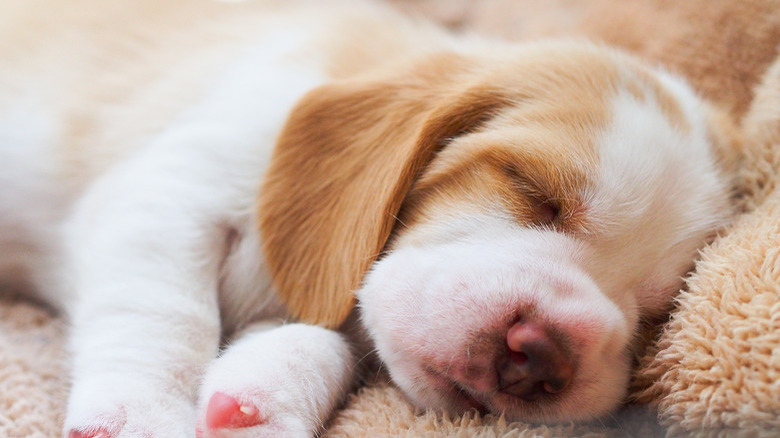Female Puppies & Nipple Development
When sexing newborn puppies, you won't look at the nipples to determine gender. Male and female puppies both have nipples, but as with other male mammals, nipples won't serve as a food source for future offspring. Nipple color is either pink or dark, depending on your dog's coloring. While a female puppy's nipples are an afterthought at this stage of her life, as she ages you should take stock of her mammary glands regularly to make sure she isn't experiencing any problems in that area.
Dog nipple numbers
While female humans have two breasts, the number of mammary glands on dogs isn't necessarily uniform. As Dogster points out, canines have eight to 10 nipples on average, and some dogs may have an odd number rather than a symmetrical nipple row on each side. Even more surprising, nipples may show up in areas other than the abdomen.
The first heat cycle
If your puppy isn't spayed before her first heat cycle, which normally takes place about the age of six months, you will notice that her mammary glands swell at that time. The swelling usually occurs in the few days before and after the heat cycle. While the swelling is normal, any type of discharge from the nipples is not. Keep your puppy indoors except for walks during her heat cycle, as male dogs are known to climb over or dig under fences to mate with unsupervised females in heat.
Nipples and pregnancy
When your dog is bred, enlarged nipples are one of the first signs that the pregnancy "took." That initial enlargement is followed by continued swelling as the birth approaches. Often, a milk discharge is one of the signs that a dog will give birth within a day or so.
Nipples while nursing
Once the puppies arrive, nipples perform the function for which they were designed. Nursing takes a lot out of a dog, and inflammation from constant suckling may affect the nipples. Once the puppies are weaned, the nipples will shrink somewhat but will stay larger than they were before her giving birth. For most dogs, permanent nipple stretching results.
Some dogs may develop mastitis, a breast infection, while nursing. Not only are the nipples inflamed, but pus is discharged through the nipple. The condition is very painful, and your dog requires immediate veterinary attention.
Nipple issues
As your puppy grows, she may become vulnerable to various nipple issues. If you notice any discharge or swelling coming from your dog's nipples, take her to the veterinarian for an examination. While some of these issues may arise during lactation, others have little to do with reproduction or nursing.
Intact females are more likely to develop mammary gland cancer, as are female dogs who were over the age of two years when spayed. Symptoms of canine mammary gland cancer include lumps beneath the skin. If you're lucky, these lumps will turn out to be cysts, but it's crucial to have your dog examined by a vet as soon as possible. As with any cancer, early detection may save your dog's life.
If a dog is not spayed and not bred, she may develop false pregnancy symptoms. Such a dog develops all of the signs of pregnancy, including swollen nipples, without actually carrying any fetuses.
Always check with your veterinarian before changing your pet's diet, medication, or physical activity routines. This information is not a substitute for a vet's opinion.
